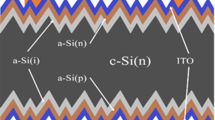Abstract
The dark current–voltage of the Au/n+(a-Si:H)/n(SiGe)/p(c-Si)/Ag heterojunction structure have been investigated in order to determinate the electrical conduction mechanisms. The forward current at different temperatures was found to be increased exponentially at low applied voltage \((V \le 0.4 {\text{V}})\) indicating that the conduction mechanism of the diode was controlled by the thermionic emission mechanism. While, at bias voltages higher than 0.5 V, the results obtained show that the carriers conduction was described by the space charge limited current mechanism. The effect of front surface field (FSF) on the photovoltaic parameters of Au/n+ (a-Si:H)/n(SiGe)/p(c-Si) heterojunction solar cell is studied. The experimental results obtained yielded to an improvement of about 50 mV for the open-circuit voltage, 1.1 mA cm−2 for the short-circuit current density, and about 1% for the cell efficiency compared to the conventional cell i.e. without a-Si:H thin layer (FSF).










Similar content being viewed by others
References
Ahaitouf, A., Losson, E., Bath, A.: On the determination of interface state density in n-InP Schottky structures by current–voltage measurements: comparison with DLTS results. Solid-State Electron. 44, 515–520 (2000)
Anthopoulos, T.D., Shafai, T.S.: Low frequency capacitance characterization of α-phase nickel phthalocyanine/lead interfaces: effects of temperature and oxygen doping. J. Phys. Chem. Solids 65, 1345–1348 (2004)
Aydın, M.E., Yakuphanoglu, F.: Electrical and interface state density properties of the 4H-nSiC/[6, 6]-phenyl C 61-butyric acid methyl ester/Au diode. Microelectron. Eng. 85, 1836–1841 (2008)
Cheung, S.K., Cheung, N.W.: Extraction of Schottky diode parameters from forward current–voltage characteristics. Appl. Phys. Lett. 49, 85 (1986)
Diaham, Sombel, Locatelli, Marie-Laure: Space-charge-limited currents in polyimide films Appl. Phys. Lett. 101, 242905 (2012)
El-Nahass, M.M., El-Zaidia, E.F.M., Ali, M.H., Zedan, I.T.: Current–voltage and photovoltaic characteristics of n-Ge 10 Se 80 In 10/p-Si heterojunction. Mater. Sci. Semicond. Process. 24, 254–259 (2014)
Etinkara, H.A.C., Turut, A., Zengın, D.M., Erel, S.: The energy distribution of the interface state density of Pb/p-Si Schottky contacts exposed to clean room air. Appl. Surf. Sci. 207, 190–199 (2003)
Farag, A.A.M., Terra, F.S., Ashery, A., Mansour, A.M.: Structural and electrical characteristics of n-InSb/p-GaAs heterojunction prepared by liquid phase epitaxy. J. Alloys Compd. 615, 604–609 (2014)
Fitzgerald, E.A., Currie, M.T., Samavedam, S.B., Langdo, T.A., Taraschi, G., Yang, V., Leitz, C.W., Bulsara, M.T.: Dislocations in relaxed SiGe/Si heterostructures. Phys. Status Solidi (a) 171, 227 (1999)
Fortes, M., Comesan, E., Rodriguez, J.A., Otero, P., Garcia-Loureiro, A.J.: Impact of series and shunt resistances in amorphous silicon thin film solar cells. Sol. Energy 100, 114–123 (2014)
Gould, R.D., Rahman, M.S.: Power-law currents in some ZnO-Sn composite materials. J. Phys. D 14, 79 (1981)
Hadi, S.A., Hashemi, P., DiLello, N., Polyzoeva, E., Nayfeh, A., Hoyt, J.: Thin-film Si1−x Gex HIT solar cells. Sol. Energy 103, 154–159 (2014)
Hussein, R., Borchert, D., Grabosch, G., Fahrner, W.R.: Dark I–V–T measurements and characteristics of (n) a-Si/(p) c-Si heterojunction solar cells. Sol. Energy Mater. Sol. Cells 69(2), 123–129 (2001)
Kadri, E., Krichen, M., Arab, A.B.: Effect of the front surface field (a-Si:H) on the spectral response of thin films heterojunctions solar cells. J. Comput. Electron. 14(2), 557–565 (2015)
Kadri, E., Krichen, M., Elleuch, S., Arab, A.B.: Optical properties of Si1−xGex/Si thin films. Opt. Quantum Electron. 48, 352 (2016a)
Kadri, E., Krichen, M., Arab, A.B.: Analytical method for the analysis of thin SiGe/Si solar cells with front surface field. Opt. Quantum Electron. 48, 305 (2016b)
Larry Lee, M., Dezsi, G., Venkatasubramanian, R.: Analysis of SiGe/Si quantum dot superlattices grown by low-pressure chemical vapor deposition for thin solar cells. Thin Solid Films 518, 576–579 (2010)
Lindholm, F.A., Neugroschel, A., Pao, S.C., Fossum, J.G., Sah, C.T.: Design considerations for silicon HLE solar cells. In: 13th Photovoltaic Specialists Conference, pp. 1300–1130 (1978)
Liou, J.J.: Physical models for predicting the performance of Si/Si, AlGaAs/GaAs, and Si/SiGe solar cells. Sol. Energy Mater. Sol. Cells 29, 261–276 (1993)
Mooney, P.M.: Strain relaxation and dislocations in SiGe/Si structures. Mater. Sci. Eng. R: Rep 17, 105–146 (1996)
Rabinal, M.K., Sangunni, K.S., Gopal, E.S.R.: Chemical ordering in Ge20Se80−χInχ glasses. J. Non-Cryst. Solids 188, 98–106 (1995)
Rhoderick, E.H., Williams, R.H.: Metal-Semiconductor contacts. Oxford University Press, London (1988)
Sah, C.T., Lindholm, F.A., Fossum, G.: A high-lowjunction emitter structure for improving silicon solar cell efficiency. IEEE Trans. Electron. Devices 25, 66–67 (1978)
Soliman, H.S., Farag, A.A.M., Khosifan, N.M., El-Nahass, M.M.: Electrical transport mechanisms and photovoltaic characterization of cobalt phthalocyanine on silicon heterojunctions. Thin Solid Films 516, 8678–8683 (2008)
Sze, S.M.: Physics of Semiconductor Device, 2nd edn. Wiley, New York (1981)
Usami, N., Pan, W., Fujiwara, K., Tayanagi, M., Ohdaira, K., Nakajima, K.: Effect of the compositional distribution on the photovoltaic power conversion of SiGe solar cells. Sol. Energy Mater. Sol. Cells 91, 123–128 (2007)
Yahia, I.S., Fadel, M., Sakr, G.B., Yakuphanoglu, F., Shenouda, S.S., Farooq, W.A.: Analysis of current–voltage characteristics of Al/p-ZnGa 2 Se 4/n-Si nanocrystalline heterojunction diode. J. Alloys Comp. 509, 4414–4419 (2011)
Yakuphanoglu, F.: The current–voltage characteristics of FSS/n-Si heterojunction diode under dark and illumination. Phys. B 388, 226–229 (2007)
Yakuphanoglu, F.: Photovoltaic properties of the organic–inorganic photodiode based on polymer and fullerene blend for optical sensors. Sens. Actuators A 141, 383–389 (2008)
Zouari, A., Arab, A.B.: Effect of the front surface field on crystalline silicon solar cell efficiency: solar cells. Renew. Energy 36, 1663–1670 (2011)
Author information
Authors and Affiliations
Corresponding author
Rights and permissions
About this article
Cite this article
Kadri, E., Krichen, M., Mohammed, R. et al. Electrical transport mechanisms in amorphous silicon/crystalline silicon germanium heterojunction solar cell: impact of passivation layer in conversion efficiency. Opt Quant Electron 48, 546 (2016). https://doi.org/10.1007/s11082-016-0812-7
Received:
Accepted:
Published:
DOI: https://doi.org/10.1007/s11082-016-0812-7




